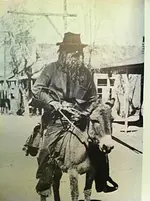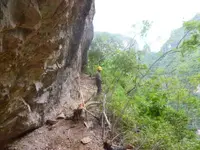Roadrunner wrote
The book I just received says this.
Supposibly between the years 1881 and 1889 <snip>
I am not, and would not defend this particular book <Fools Gold, by Robert Sikorsky.> and only refer to a single point, which is not unique to this book, the alleged Wells Fargo receipts. One of the other sources that refers to the shipment receipts (McGee letters)
was not even intended for publication, which one could say lends further credence to it being genuine.
Springfield wrote
It's interesting that the search for the 'Lost Dutchman Mine' over the past 120 years has apparently come up empty and has been replaced with a search for 'Clues for the lost Dutchman Mine', which has yielded similar meager results. There might be a message in this.
The clues began in Phoenix with Jacob Waltz (or whatever his name was) and some ore allegedly found under his bed following his death. Since then, a 'fabulous lost mine' legend has provided a challenging puzzle for researchers trying to establish the facts. It remains a mighty cold trail. It would be terrific if a receipt for an ore shipment surfaced with Waltz's name on it - it would add credibility to the whole story. As Dandy Don Meredith used to say, "If 'ifs' and 'buts' were candy and nuts, we'd all have a Merry Christmas."
Waltz signed his own name as Jacob Waltz on his naturalization papers, one would assume that he would sign his own name the way it is supposed to be. If the story about the candle box of ore beneath the bed is false, then how do you explain that both Julia & Reiney, as well as Holmes, make reference to it, as well as Holmes explanation of what he did with the proceeds? You must also discount that Holmes went on to spend the rest of his life hunting the mine, or do you simply put Holmes, Julia, the Petrasches and all the rest of those who hunted the mine right after Waltz was dead among the delusional? This whole approach may be quite scientific - that a thing must be false until proven true - but has not worked for anyone to find a lost mine, Dutchman or no. Those whom have been successful have taken the opposite approach - that it is true until proven false.
It is also interesting that in that time span since the death of Waltz, especially in the first several decades, several excellent, rich gold deposits were indeed found, some as a direct result of the search for Waltz's mine. Goldfield for instance as a major example, but the old newspapers are dotted with reports of new mines being found, believed to be the Dutchman's mine (none proved to be, which did not matter to the finders as they got gold anyway) so the search has not exactly been completely un-productive in terms of gold production. An extract:
The production of Goldfield Mining District from 1893 to 1986 is reported to be 60, 226 ounces of gold and 21, 402 ounces of silver. The three greatest producing mines were the Mammoth, Bull Dog and Black Queen. The list of mines in the Gold field Mining District include :
Mammoth, Bull Dog, Black Queen, Old Wasp, Bluebird,
Mammoth 2, Tom Thumb, Golden Hillside, Fair Strike,
Copper Crown, Palmer, Treasure Vault, High Flyer, Gold
Bond, Lazy Doc, Gold Strike, Iron Horse (Lucky Boy)
History of Goldfield Minig District
**
Side point - most all lost mine legends have the most tenuous sort of "proof" rather than ore shipment registers or receipts, assay reports and mining claim deeds; this sort of documentation simply was not a part of the actual common practice of the 'frontier' days. In a gold rush, where a new area was discovered and someone filed a claim, the whole area would be immediately staked off and claimed by others, so we have fairly good records of such mines. But when someone found a rich deposit and wished to keep it from being over-run by others or simply stolen, there is not going to be claim maps, assay reports, detailed info of any kind. The Lost Dutchman is a bit different in that Holmes did have an assay done (demanded by the buyer of the ore) and that at least some specimens were saved in the form of jewelry; we have statements of witnesses who said they saw Waltz selling gold ore too. Gold ore comes from a mine. Waltz told his closest friends that he had a mine, and pointed to the Superstitions to indicate where it is, even tried to take them to it once. I am sorry if this is not enough to prove the case for you (anyone reading this) but this is all you get. You also get tons of misinformation and pure BS that others have added on to the basic story. If you don't make an effort to filter out the added on BS, you will be discouraged.
Old Bookaroo wrote
I keep returning to the reference cited above. At this point it's simply hard to believe he had a mine. Why would he have been living in what amounted to poverty if he didn't have to?
How do you define living in poverty, circa 1889? Waltz had his own home and seemed to be comfortable; he did not really work hard to make a large farm, more like the little farming he did (some chickens and a mule or burro) was on the level of a hobby. The candlebox of ore weighed some 48 pounds, which had been assayed at $110,000 per ton (@$20.67 per ounce) so using a little math would amount to about $2640 ($20.67 price) or over $165000 today. This may not be wealthy by your standards, I do not know, but is not what I would consider living in poverty. Waltz appears to have been comfortable, not one seeking to be as rich as he could ever be, and there are people like that today. Not everyone would try to become as wealthy as possible, given the chance.
Last point but I have to respectfully disagree about it being hard to believe that Waltz had a mine. Jacob Waltz had proven that he was a capable prospector in having helped find (and develop) several rich gold mines in the Bradshaws before coming to Phoenix; he was seen in Florence getting prospecting supplies and among old-timers, it was (according to them) "no big secret" that he had a rich gold mine in the Superstitions, only later did it become such a secret. Waltz also told his closest friends that he had said mine - you must discard and dismiss all of this to conclude that he had no mine. As an aside, we have to discard the Dr John Walker story as well, and conclude that Weiser did not come to the Pima villages, did not tell his story and die there etc.
Do not take my word on any part of this - do your own research and try to stick to the oldest sources available when possible. Admitted, some excellent research has been done by later authors, but also a great deal of BS has been published and circulated. If you are the type that needs absolute, scientifically-verifiable proof before you can proceed,
you should find another hobby.


Good luck and good hunting to you all, I hope you find the treasures that you seek.
Oroblanco







